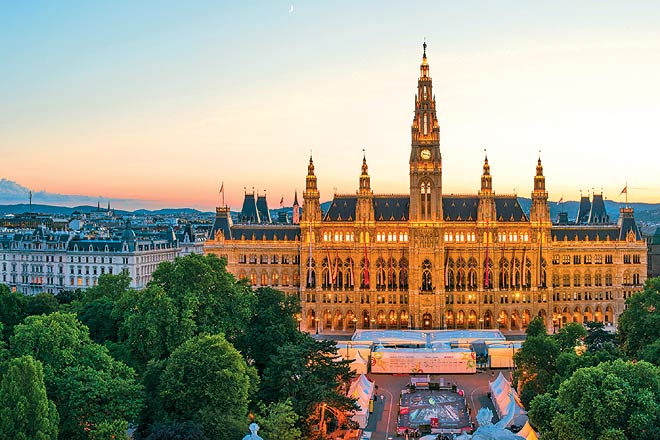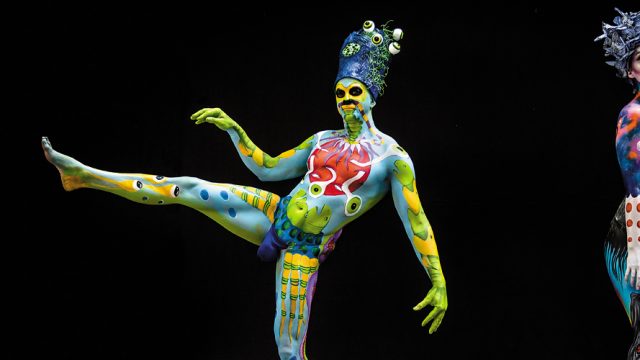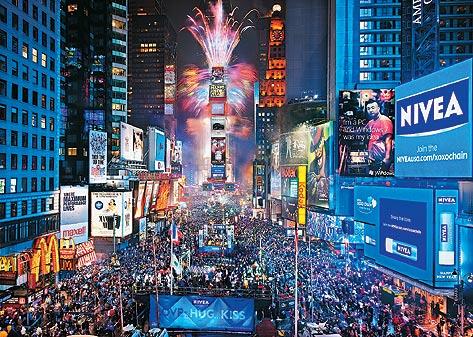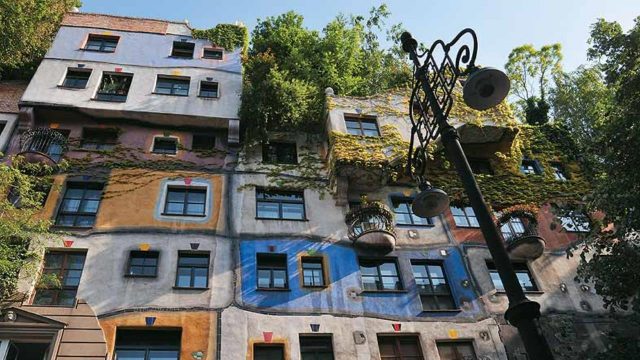Ingrid, the motherly Austrian Airlines flight attendant, peered out of the aircraft window and shook her head,

Our car sped along the highway through the late winter (early February) chill, zipping past tall Austrian pines. At last we turned a bend and the Ringstrasse appeared, looking like a sweep of platinum, the still-burning street lamps glittering like studded diamonds. Our first destination was the Imperial Hotel, a former royal palace of the Habsburg Dynasty, situated on the Ringstrasse itself. By the clock on the street tower, it was seven o’clock. It would still be a while before the city was fully awake.
Every road, every street, every lane and bylane anywhere in the world arrives into the present carrying its own untold stories and memories from the past: stories of how it came to be and memories of those who traversed it—before plunging into the unknown future. Some have humble origins: mere foot-trodden pathways that perhaps slowly grew into full-fledged walkways. A rare few have the privilege of stamping their way into the pages of documented history, very much like royalty amid a sea of commoners. The Ringstrasse is one of these regal roads, born with a silver spoon in its mouth. It was inaugurated on May 1, 1865 by Emperor Franz Joseph I to showcase the glory of the Habsburg Empire.
Way back in the 13th century, the land was part of a glacis, 500 metres in diameter, which circled around a set of fortifying city walls erected to prevent enemy sieges and funded by ransom money collected in exchange for the release of England’s Richard I. The walls were reinforced later, following the first Turkish siege of 1529. During this time, construction within the area was banned, and even cultivation of any kind of vegetation strictly forbidden. Following the Revolution of 1848, however, the walls were brought down. It is said that since the outer districts surrounding the city had been annexed into the municipality, the walls had become an impediment to free movement of traffic. Another version of the story has it that Franz Joseph I was a fair ruler and he wanted to bridge the gap between the elite of the inner circle and the middle and lower classes. What we do know for certain is that it was Franz Joseph I who, in a historic statement that has come to be known as the ‘It is MY will’ (‘es ist Mein Wille’) document, ordered the demolition, paving the way for the majestic Ringstrasse to be created.

Today, most of the important buildings that line the Ringstrasse date back to the time of Franz Joseph I, when the emperor himself meticulously planned not just the geographical positions, but also the functions of each construction. An entire architectural style—known as the Ringstrasse style—emerged. Characterised by ‘historicism’, in which the design of a particular structure adheres to an existing historical style that best reflects the function the building is meant to serve, the Ringstrasse makes for one of the most delightful experiences in architectural sightseeing. At every turn, you find the harmonious coexistence of disparate architectural designs, very much like a medley of mellifluous sounds in an orchestra (which is another of the Ringstrasse’s legacies, housing as it does the opera houses frequented by one of Vienna’s most famous citizens—Mozart). And so, the Hellenistic (Parliament House) gracefully gives way to a Neo-Gothic (City Hall) perhaps or to an Italian Renaissance (university). The emperor commissioned artists to conceptualise the designs. Architect Theophil von Hansen chose the Hellenistic style for the parliament because it stood for classical Athens’ democratic values, and Friedrich von Schmidt designed the City Hall in Neo-Gothic to usher in a sense of the civic autonomy of the city of Flanders from where the design originated.
I felt a snowflake land on my cheek. Then another. And another. To our utter disbelief, it started to snow. At first lightly. Then it fell on us in a torrent, cascading down from the heavens like a downy waterfall, the high wind soon turning it into a semi-blizzard. “Snowfall is extremely unusual at this time of year,” said our guide Isle Heigerth, looking worried. She had the responsibility of showing us around the Ringstrasse, which was already beginning to look more like an arctic zone. And it had snowed for barely 15 minutes. After an 2015hour, snow covered the entire ground, hung from the tops of buildings and clung to the leafless trees. It was barely eleven in the morning, but we all agreed to ‘go in for an early lunch’—not so much because we were hungry, but to escape the biting cold. “And in any case, all the buildings look the same right now,” quipped one of our group. So, like a team of polar explorers, we trudged along, leaving our footprints—if only for a few fleeting moments—in the pristine, shifting snow of time. Maybe, just maybe, we were making a permanent mark in the memory that the Ringstrasse would indelibly, inevitably, carry into the uncharted future.
I ordered rindsuppe, a clear beef soup sprinkled with seasonal vegetables and spices, which I was told is the preferred choice of farmers in the Austrian Alps, who, on cold winter evenings after a hard day’s work, return home with thoughts of a steaming bowl waiting on the kitchen table. For the main course, I chose another traditional Viennese favourite, the tafelspitz—boiled and roasted potatoes with wild chives. And washed it down with a glass of the finest Veltliner, a dry white Viennese wine (Vienna is among the few remaining capital cities in the world with its own vineyards). You could, of course, opt for the world famous wiener schnitzel (a cutlet of veal or pork) though diet-conscious Viennese are reportedly shunning it these days. “You know how it’s prepared, right?” a waitress taking my order asked before going on to explain. “The meat is pounded flat, dipped in a batter of egg, flour and breadcrumbs, and finally fried in clarified butter. It’s quite fattening.” She got a stern look of disapproval from a passing colleague. “But it’s delicious,” she quickly added.
The fetish for ‘slimness’ is not all that new here, apparently; it runs in the blue-blooded veins of the Austrian Empire. Empress Elisabeth, wife of Franz Joseph I, was as much obsessed with it as any young Viennese of today. The Hofburg Palace, which was once the Vienna home of the royal couple and is now a magnificent museum housing the rarest paintings and sculptures, has an entire section dedicated to showcasing the items of her beauty and fitness regime, including a ‘gym’ of sorts, where the queen ‘worked out’. It doesn’t have a treadmill, but on display is a range of exercise equipment and even a wooden bar, presumably for push-ups. Named after the empress (Sisi was the nickname by which she was popularly known), the Sisi Museum is a treasure trove of exquisite jewellery. It also has a fascinating collection of dresses and corsets worn by the queen with waistlines so thin, they would make Cinderella blush. “It was unusual for her time, when voluptuous women were considered beautiful,” observed Ilse. But then, Sisi was hardly conventional. Known as much for her beauty as her love of the common people, she shunned court conventions, rejected claustrophobic traditions and even travelled unescorted—unthinkable for a queen in those days—though this ultimately cost her her life. She was murdered by an anti-royalist protestor on one such sojourn to Geneva in 1898.

In Vienna, inclement weather is hardly reason to complain. Other than nostalgic walks through the corridors of royal palaces and museums, you can let the sound of music lure you indoors to the Opera House, where Mozart and Strauss mesmerised audiences with their symphonies, or allow yourself to be drawn in by the promise of a dramatic performance at one of the many theatre houses.
Restaurants and cafés, big and small, serving scrumptious traditional Viennese cuisine dot the Ringstrasse, as do a number of roadside eateries, especially sausage stalls operated by street vendors known as wurstelstand.

Vienna is also home to some of the best-loved cakes and desserts in the world. Arguably the most sought after is the Sachertorte, a chocolate cake filled with apricot jam, the secret recipe of which is passed down from generation to generation in the Sacher family (members of whom served in the Habsburg kitchens), who run the Sacher Hotel along the Ringstrasse. Possibly like in no other part of the world, even the culinary experience in Vienna, and specifically around the Ringstrasse, is imbued with an inexplicable elegance that seems linked to its cultural consciousness.
Like the ‘charm bracelet’ it is supposed to resemble, the Ringstrasse circles around all of this, embracing and protecting, turning it into some enchanted space, which is more than just a locus of museums, music halls, art galleries, operas, theatres, or royal palaces. Come rain, come shine. Come snowstorm. The Ringstrasse is always “around.”
The information
Getting there: Several international airlines, including Air India, Austrian Airlines and Emirates, fly to Vienna (round-trip economy-class tickets from Rs 43,000). I flew and highly recommend Austrian Airlines’ business class, not just for comfort, but also for the infectious friendliness and warmth of the flight attendants.
Visa: You will need a Schengen visa to travel to Vienna (www.vfs-austria.co.in/tourist.html; Rs 4,130). It is best to apply in person directly at the Austrian embassy in New Delhi (011-24192700, www.aussenministerium.at/newdelhi) or at the consulates(www.austria.visahq.in/embassy/india) in Kolkata, Chennai, Mumbai and Goa.
Currency: €1 = Rs 68
Where to stay: Created two years before the Ringstrasse in 1863, Hotel Imperial (from Rs 26,000; www.aussenministerium.at/newdelhi) was the Vienna residence of a prince, who often hosted visiting royalty. Ten years later, its rooms were opened to the public, and its premises became the preferred haunt of artists, composers, musicians, writers and, nowadays, celebs. From my room, I had a ringside view of the Ringstrasse. I cherished the early mornings, sipping coffee by the window at the cozy café downstairs. Do take a stroll down the corridors for a sense of the history surrounding the place.
Hotel Am Parkring (from Rs 5,500;www.am-parkring-schick-vienna.h-rez.com), located across from the Stadt park, occupies the 11th through 13th floors of the highest building on the Ringstrasse and offers a panoramic viewof Vienna.
You could also consider Apartment Karlsplatz (from Rs 5,100; book via www.flipkey.com),a premium rental apartment located at a 5-min walk from the Karlsplatz Metro Station and Opera House. The Naschmarkt, with specialty shops and restaurants, is also close by.
What to see & do: Ringstrasse was cultivated to be a showpiece of art and culture and you’ll be reminded of this fact every step you take along this 5-km-long, 57-m-wide road. Among the many attractions here, some have gained more fame than others for various reasons, including the sheer grace and beauty of their architecture, their historical significance, their political importance, or even the ‘secrets’they house.
A must-see is the Museum of Natural History (9am–6.30pm, closed Tuesdays; €10; www.nhm-wien.ac.at), which is stocked with collections gathered over three major expeditions to Brazil, the North Pole and many other parts of the world in the 19th century. It houses the world famous Venus of Willendorf.
The Albertina (10am–6pm; €11.90; www.albertina.at) is the largest of the former private residences of the Habsburg dynasty. It houses one of the world’s greatest art collections, from Monet to Picasso.
Visit the Kaiser appartments, Sisi Museum and Silberkammer (9am–5.30pm; €11.50; www.hofburg-wien.at) if you want to know the secrets of the love life of the king and his beloved queen, why they had separate bedrooms, and why she ‘gifted’ him a mistress.
There’s also the Sigmund Freud Museum (10am–6pm; €7.50; www.freud-museum.at), where the father of psychoanalysis lived and worked for over 50 years.
In terms of sheer architectural brilliance and size, the Parliament House, which has been described by a Vienna magazine to be ‘equal to three football pitches’, should not be missed. It may only be admired from outside, of course.
If you are a lover of music, plan for an evening at the Vienna State Opera House, where concerts take place every day (ticket prices vary; often hotels book on request).
Take a slight detour from the Ringstrasse and walk along the banks of the Danube, which, being a lover of rivers, I could not resist. I took the subway from the Karlsplatz station (Ringstrasse is well-connected by the underground rail) and got off at Danube Insel. It was early in the morning, very cold, and there wasn’t a soul in sight other than white river swans. The water was gray-blue and so serene. It was the most unforgettable moment of the trip for me.
Ringstrasse
Vienna
Leave a Reply
You must be logged in to post a comment.





